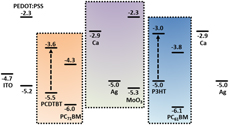Article contents
Effects of interlayer properties on the performance of tandem organic solar cells with low and high band gap polymers
Published online by Cambridge University Press: 23 May 2019
Abstract

Tandem organic solar cells with two stacked cells were fabricated using semiconducting polymers and fullerene derivatives. A thin intermediate multilayer of calcium, silver, and molybdenum oxide connects the front and the back cells. Bulk heterojunction (BHJ) films of the low band gap (BG) polymer, poly[N-9″-heptadecanyl-2,7-carbazole-alt-5,5-(4′,7′-di-2-thienyl-2′,1′,3′-benzothiadiazole)] (PCDTBT), and [6,6]-phenyl C71-butyric acid methyl ester (PC71BM) are used for the front cell. As for the back cell of the tandem structure, the same PCDTBT:PC71BM BHJ (T1) or the high BG polymer poly(3-hexylthiophene) (P3HT) blended with [6,6]-phenyl-C61-butyric acid methyl ester (PC61BM) BHJ (T2) are used. The critical role of interlayer properties on the photovoltaic performance of devices are investigated. The observed open-circuit potential for the tandem cell approaches the sum of the potentials of the two respective subcells, demonstrating the potential for increasing the voltage of the solar cell using the tandem structure even with same or lower band gap polymer in the front.
Keywords
- Type
- Article
- Information
- Copyright
- Copyright © Materials Research Society 2019
References
- 10
- Cited by




